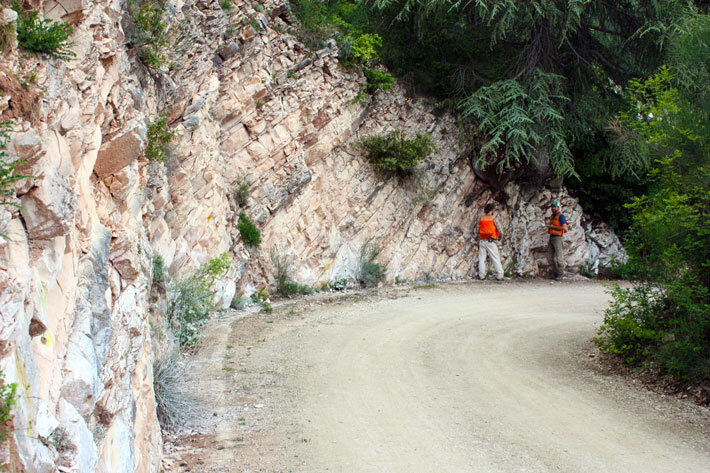Welcome to DU!
The truly grassroots left-of-center political community where regular people, not algorithms, drive the discussions and set the standards.
Join the community:
Create a free account
Support DU (and get rid of ads!):
Become a Star Member
Latest Breaking News
General Discussion
The DU Lounge
All Forums
Issue Forums
Culture Forums
Alliance Forums
Region Forums
Support Forums
Help & Search
Science
Related: About this forumDid the Earth tip on its side 84 million years ago?
From phys.org:

Scaglia Rossa Limestone exposed near Furlo, Italy, in the Northern Apennine Mountains. Limestone at this locality accumulated on the bottom of a shallow sea, in an arm of the ancient Mediterranean ocean nearly 85 million years ago, during what is called Late Cretaceous time. Credit: Ross Mitchell.
______________________________________________________________________________________________
Hold on to your hats, because scientists have found more evidence that Earth tips over from time to time. We know that the continents are moving slowly due to plate tectonics, but continental drift only pushes the tectonic plates past each other. It has been debated for the past few decades whether the outer, solid shell of the Earth can wobble about, or even tip over relative to the spin axis. Such a shift of Earth is called "true polar wander," but the evidence for this process has been contentious. New research published in Nature Communications, led by the Earth-Life Science Institute (ELSI) at Tokyo Institute of Technology's Principle Investigator Joe Kirschvink (also a Professor at Caltech) and Prof. Ross Mitchell at the Institute of Geology and Geophysics in Beijing, provides some of the most convincing evidence to date that such planetary tipping has indeed occurred in Earth's past.
True polar wander bears some dissecting. The Earth is a stratified ball, with a solid metal inner core, a liquid metal outer core, and a solid mantle and overriding crust at the surface which we live on. All of this is spinning like a top, once per day. Because the Earth's outer core is liquid, the solid mantle and crust are able to slide around on top of it. Relatively dense structures, such as subducting oceanic plates and massive volcanoes like Hawaii, prefer to be near the Equator, in the same way that your arms like to be out to your side when you are spinning around in an office chair.
Despite this wandering of the crust, Earth' magnetic field is generated by electrical currents in the convecting liquid Ni-Fe metal of the outer core. On long time scales, the overlying wander of the mantle and crust does not affect the core, because those overlying rock layers are transparent to Earth's magnetic field. In contrast, the convection patterns in this outer core are actually forced to dance around Earth's rotation axis, which means that the overall pattern of Earth's magnetic field is predictable, spreading out in the same fashion as iron filings lining up over a small bar magnet. Hence, these data provide excellent information about the direction of the North and South geographic poles, and the tilt gives the distance from the poles (a vertical field means you are at the pole, horizontal tells us it was on the Equator). Many rocks actually record the direction of the local magnetic field as they form, in much the same way that a magnetic tape records your music. For example, tiny crystals of the mineral magnetite produced by some bacteria actually line up like tiny compass needles, and get trapped in the sediments when the rock solidifies. This "fossil" magnetism can be used to track where the spin axis is wandering relative to the crust.
"Imagine looking at Earth from space," explains Kirschvink "True polar wander would look like the Earth tipping on its side, and what's actually happening is that the whole rocky shell of the planet—the solid mantle and crust—is rotating around the liquid outer core." Although scientists can measure true polar wander occurring today very precisely with satellites, geologists still debate whether large rotations of the mantle and crust have occurred in Earth's past.
more ...
The full paper is open access and can be read here.
InfoView thread info, including edit history
TrashPut this thread in your Trash Can (My DU » Trash Can)
BookmarkAdd this thread to your Bookmarks (My DU » Bookmarks)
2 replies, 1369 views
ShareGet links to this post and/or share on social media
AlertAlert this post for a rule violation
PowersThere are no powers you can use on this post
EditCannot edit other people's posts
ReplyReply to this post
EditCannot edit other people's posts
Rec (5)
ReplyReply to this post
2 replies
 = new reply since forum marked as read
Highlight:
NoneDon't highlight anything
5 newestHighlight 5 most recent replies
= new reply since forum marked as read
Highlight:
NoneDon't highlight anything
5 newestHighlight 5 most recent replies
Did the Earth tip on its side 84 million years ago? (Original Post)
Jim__
Oct 2021
OP
Cracklin Charlie
(12,904 posts)1. I do believe this.
And I think it could happen again, if the polar ice caps melt. I wonder if the ice caps are what has kept us “in place” on the imaginary axis.
Just a thought that keeps me awake at night.
jeffreyi
(1,938 posts)2. I already like this paper.
Author says "these data" instead of the alternative.